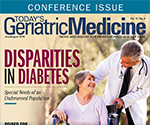 |
Researchers recently looked at long term care facilities in Belgium, England, Finland, Italy, the Netherlands, and Poland for factors that contributed to recognition of residents’ terminal phase and the expectation of their deaths. From a range of European universities and institutes, they found that increased physician visits improved awareness of patients’ imminent death and increased ability of clinicians to provide palliative care in the last week of life.
In addition to reading our e-newsletter, be sure to visit Today’s Geriatric Medicine’s website at www.TodaysGeriatricMedicine.com, where you’ll find news and information that’s relevant and reliable. We welcome your feedback at TGMeditor@gvpub.com. Follow Today’s Geriatric Medicine on Facebook and Twitter, too.
— Kate Jackson, editor |
 |
 |
LTCF-Physician Collaboration Helps Ensure Timely Palliative Care at End of Life
Joint collaboration between long term care facilities (LTCFs) and physicians can facilitate the recognition of a resident’s terminal phase and help ensure timely provision of palliative care, according to a study recently published in the Journal of the American Medical Directors Association.
In “Physician Visits and Recognition of Residents’ Terminal Phase in Long-Term Care Facilities: Findings from the PACE Cross-Sectional Study in 6 EU Countries,” the authors looked at LTCFs in Belgium, England, Finland, Italy, the Netherlands, and Poland. They examined elements including the number of physician visits, the residents’ main treatment goal, and whether physicians recognized residents’ terminal phase and expected each person’s death.
They found that the number of physician visits to residents varied significantly between countries (ranging from 15 visits in the last week of life to one) and that physicians from Poland and Italy were least inclined to recognize when a resident was in the terminal phase. Overall, however, the authors found a positive association between the number of physician visits and the recognition of a resident’s terminal phase, as well as a correlation between number of physician visits and residents having palliation as a main treatment goal in the last week of life.
Full story » |
 |
 |
 |
Disparities in Diabetes
Geriatricians must be aware of numerous disparities in health care for Hispanic individuals living with diabetes. Read more »
Pain: The Role of Nutrition
Research indicates that certain nutrients may mitigate pain in older adults by reducing inflammation. Read more »
Fall Prevention
There are practical steps geriatricians can take to help all their patients prevent falls. Read more » |
 |
 |
Eyesafe
Eyestrain is becoming more prevalent as individuals are increasingly exposed to high-energy blue light emitted from a range of devices. Among the symptoms that may occur with frequent prolonged use of devices are insomnia, irritability, blurred vision, and dry eyes. Eyesafe technology, from Healthe, selectively filters and disperses HEV blue light to ease irritated eyes. Learn more »
CloSYS Oral Care Products
Burning mouth sores resulting from chemotherapy can cause intense pain and prevent some patients from completing chemotherapy. CloSYS, a gentle line of pH balanced oral care products made without alcohol or sulfates, offers relief to cancer patients suffering from oral mucositis. The line includes oral health rinses, toothpastes, and breath spray. Learn more » |
 |
 |
Have a product or service you want to market to geriatricians, other physicians and the geriatric care team of professionals who treat aging patients? Are you a recruiter looking to fill the many geriatric professional openings within a facility, physician practice, or academic institution? Then utilize the reach of Today's Geriatric Medicine to accomplish your marketing goals and fill any open positions.
Coming up in our September/October 2019 issue is our Fall Showcase. Email a sales representative to be part of this unique advertising opportunity.
A resource for professionals looking for new opportunities, as well as those physicians just curious to see what's out there, our Physician Recruitment Center gives physician recruiters a powerful tool to fill partnership opportunities, academic appointments, and hospital staff positions. To support your product marketing or recruiting needs, e-mail our experienced account executives today at sales@gvpub.com for more information or call 800-278-4400! |
 |
|
|
 |
|
|
 |
 |
Canadian Doctors Prescribe Museum Visits
In a unique partnership between the Montreal Museum of Fine Arts and the Medecins Francophones du Canada, a medical association, prescriptions are being given that entitle the user to tour the museum’s collection. Participating physicians prescribe the art immersion, according to the museum’s full-time resident art therapist, as an adjunctive remedy for a range of conditions such as depression and anxiety, cardiovascular conditions, and Alzheimer’s disease. Fortune magazine reports on studies showing the health benefits of art therapy and art appreciation.
Aid in Dying Soon Will Be Available to More Americans
This summer, two new states will join seven others that allow doctors to prescribe lethal medication for their terminally ill patients who desire it. According to a New York Times report, by October, more than one-fifth of Americans will reside in the nine states that allow individuals with fewer than six months to live some control over the way they die. But will they use it? The New York Times reports on the consequences and likely outcomes of these changes.
Link Between Common Prostate Cancer Treatment, Dementia Detailed in New Study
Recent research indicates that androgen deprivation therapy, a common treatment for prostate cancer, which works by lowering testosterone levels, is linked to dementia and, possibly, Alzheimer’s disease. Science Daily reports on new research by scientists from the Perelman School of Medicine at the University of Pennsylvania involving 50,000 patients worldwide.
An Hour of Light and Sound a Day Might Keep Alzheimer’s at Bay
As medicinal approaches prove disappointing in stemming Alzheimer’s disease, researchers increasingly explore other avenues for treating patients with the disease. Scientific American reports on a new study, recently published in Cell, that looks at the possibility of reversing signs of Alzheimer’s by exposing patients to pulsing sounds and flashing lights—an approach that’s proven successful in mice. |
 |
|
